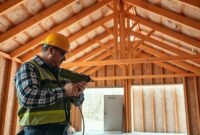How long does attic insulation last? The lifespan of your attic insulation, whether batt insulation, spray foam insulation, or another type, depends significantly on the material used.
Different insulation materials, including rock wool and polyurethane foam, offer varying lifespans and impact energy efficiency differently, with some lasting up to 100 years.
To understand how often your attic insulation needs to be replaced, especially considering the energy savings it can provide, read on for detailed insights into various insulation materials. This includes spray foam insulation for metal buildings, which can significantly reduce cooled air loss.
How Long Does Blown-in Attic Insulation Last?
You may wonder what blown-in attic insulation is. According to sources, blown-in attic insulation is several types of insulation, which refers to any insulation type that is thick, lumpy, and dense. These types of attic insulation will include fiberglass, cellulose, and other materials with such features (thick, lumpy, and dense).
How long does attic insulation last, especially when the attic insulation is blown in? Well, The lifespan of such insulation, including spray foam insulation and batt insulation, will depend on the material.
The durability of these materials varies depending on factors like installation quality and environmental conditions.

As mentioned, Common types of blown-in insulation include cellulose and fiberglass. These materials are preferred to prevent cold air from entering and reduce high energy bills. Fiberglass batts, in particular, are known for their longevity and effectiveness in insulating the ceiling and walls of a home.
While other blown-in insulation options exist, cellulose and fiberglass are notable for their cost and energy efficiency balance.
What is the lifespan of cellulose insulation material? According to sources, you can expect cellulose insulation to last 20-30 years. However, this material is said to start degrading after 15 years of installation.
The insulation material will also be easily worn out in extreme weather conditions. With such instability, you cannot expect cellulose as the first line in terms of attic insulation. That’s why people are only expecting it to be supplementary insulation.
How Long Does Fiberglass Insulation Last in Attic?
What about fiberglass insulation? Compared to cellulose, fiberglass insulation is way better. Why so? Despite its low cost, fiberglass insulation can provide a long-term 80-100 years of insulation effect. Unless it’s damaged, the long-term insulating effect should persist.
Read also: Is Fiberglass Insulation Flammable? Here is the Answer
Unfortunately, the quality of some fiberglass insulation may begin to decline after 15 years. This is a crucial time to replace your insulation to maintain proper insulation and energy efficiency. Certified home inspectors recommend inspecting your attic insulation when it reaches 10 years of age to assess its condition and decide if replacement is necessary.
Is fiberglass better?
So, is fiberglass insulation superior to cellulose insulation? In terms of durability and resistance to water damage, yes. It’s important to note that cellulose, being an organic material, can become compromised when exposed to moisture. Wet insulation loses effectiveness and can become a breeding ground for mildew and termites.
To complete your knowledge, let’s learn the pros and cons of cellulose and fiberglass insulation below.
Fiberglass insulation
Pros:
- It can be installed in the form of batts or blown in.
- It’s cost-effective, especially when compared to spray foam.
- When used as thermal insulation, fiberglass is one of the greatest options.
- It lasts long since it isn’t made from organic products and doesn’t promote mildew infestation.
- That said, it often comes with a lifetime warranty.
- You can choose various R-values from the ones offered in the market.
- It’s not flammable.
Cons:
- It is still less effective in terms of thermal insulation.
- Its particles may endanger your health as they are carcinogenic–although not all fiberglass insulation has these carcinogenic materials.
Cellulose insulation
Pros:
- Itch-free insulation material
- It is made from recycled magazines, newspapers, cardboard, and paper.
- Fire retardant as well.
- It is not chewable by insects despite being a green insulation material.
- Quite effective in insulating your attic.
- It may also help your house to become soundproof.
Cons:
- It’s prone to sagging
- It is added by many chemicals to promote its fire-retardant feature.
- It makes a lot of dust during installation, which may disturb you if you are a clean geek.
Read also: Does Fiberglass Insulation Burn? At What Temperature Does It Burn?
Is it worth the bucks to replace the insulation?
So, is insulation replacement worth it? It’s not always necessary to replace your insulation frequently unless it’s damaged or showing signs of wear, such as wet insulation or reduced effectiveness in keeping out cold air. Most insulation materials, including batt insulation, have a long lifespan. However, knowing when to replace your attic insulation is essential to avoid high energy bills and ensure your home has proper insulation.


